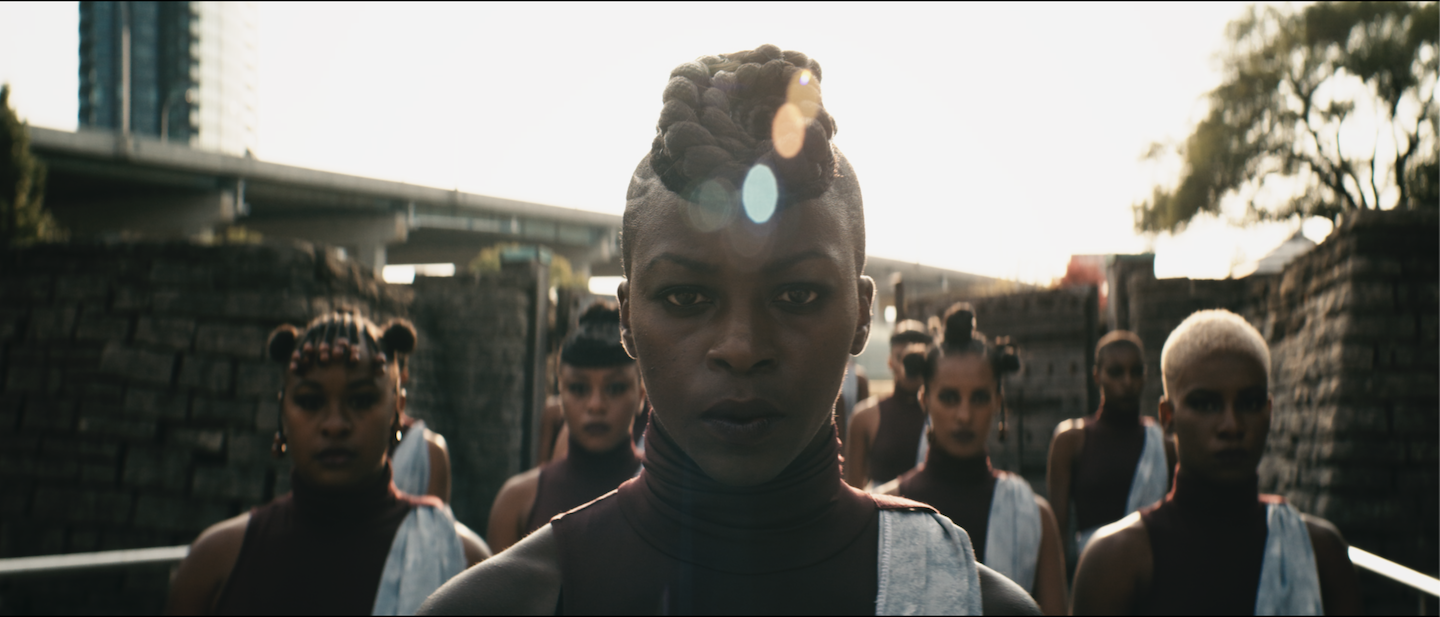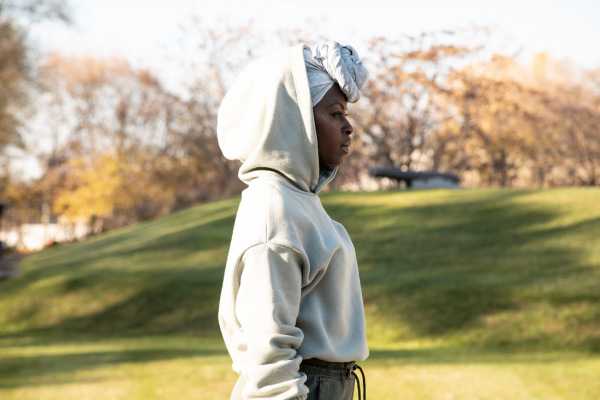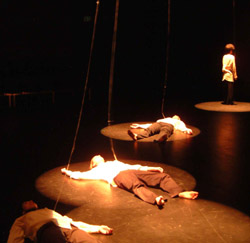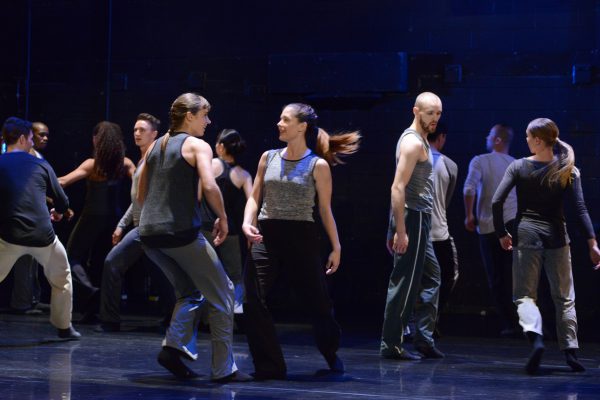On Dec. 14, 2020, Toronto History Museums released A Revolution of Love, created by Esie Mensah. The dancefilm is part of a larger project, Awakenings, an online series of art projects created by Black and Indigenous artists and artists of colour. Mensah’s film tells the story of a young Black woman considering her ancestral history and the current violence wrought upon her community. Filmed at Toronto’s Fort York in partnership with Soulpepper Theatre, A Revolution of Love tells the story of a young Black woman considering her ancestral history and the current violence wrought upon her community. Fifteen women join Mensah in using dance to envision a future in which love is the driving force of revolution. The film has more than 7,500 views on YouTube.
Mensah, a dancer and choreographer in Toronto, was asked to create the film by Umbereen Inayet, the City of Toronto programming supervisor, and assembled a large team including Weyni Mengesha (the artistic director of Soulpepper Theatre) and Lucius Dechausay (director of CBC’s The Move) as co-directors. The film features the words of Assata Shakur and the music of d’bi.young anitafrika.
Below are excerpts of a longer conversation with Mensah, facilitated by Joy Henderson. In Part I, they talk about including a spiritual advisor in the filmmaking process, how not to colonize a space and how life can unknowingly seep into art. In Part II, they talk about how colonialism has disconnected dance and spirituality.
***
Esie Mensah: So we get down to this group of women, and even to be in a room with 15 Black women with an intention of healing… And I was very insecure because up until that point, the only people that knew what I was doing in terms of my art, like my mission and mandate of creating art that heals, were my good people that had been in my work. There were like two people — one that had been in the work and one that had observed (she was an assistant) — and everybody else was brand new in this setting.
So I’m trying to introduce this idea to people of being in a space with a certain intention of just asking these women to come in with their full selves. This is not a space for competition; you don’t have to worry about having to out-dance somebody. I just actually need you to show up and be you. And that process of trying to get people to do that was really interesting. As dancers we always have 10 jobs at once. And so people are doing double duty. I often told the girls, I said, ‘I don’t want you to leave this time together and not feel like you gained something, because there was a purpose to you being in this room. There was a purpose of us being together.’ And I’ve been there — you get so wrapped up and running yourself thin that you forget why you were supposed to be a part of it.
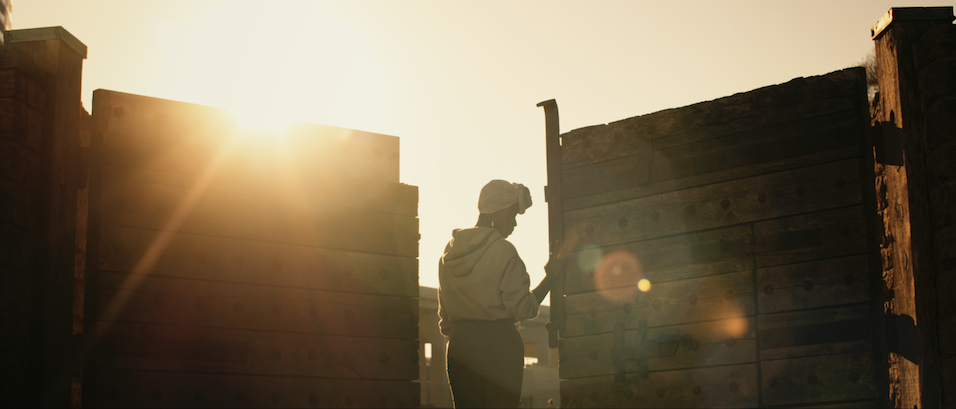
I work with a spiritual advisor. And I work very closely with my friend, a good friend and brother, Samson Bonkeabantu Brown. And he is a sangoma, which is basically a South African diviner. On our last rehearsal, everybody’s finally there, we’re finally making strides, and when we go on break he sits me down. And I still picture it: me with my fork in my hand, and he’s telling me, ‘It’s gonna look beautiful. But will it feel beautiful?’ You know? It’s like, ‘The thing about your work, Esie, is the fact that you tap into something for people. So these girls, they think that they’re going there, but they’re not there yet.’ So I had to figure out a way to kind of tell people, and I’m sitting here like, ‘Oh my God, I’m back here again. I’ve got to figure out how the heck I gotta tell these people that they’re not there yet. And not close people off. Because when you’re meeting people at different parts of their spiritual journey, it looks really different. And that process and how they encounter it … because I don’t know who you are and what you’ve been doing before you met me. So I’m coming to you, but I also am understanding that whatever you are doing is the prime reason as to why the universe brought us together. Our ancestors really brought us together. So, you know, I just was very honest. I was like, nobody has to worry about standing in the space that I am in. I’ve been doing this work for years, so I’m a lot further ahead. But just be willing to open up the door. You know, be willing to kind of step into something; be willing to allow yourself to be open to an energy to come in. When you dance, you’re dancing with an energy that’s higher than just your physical body. You’ll be dancing from spirit, which is so much of what I love to do. I think it’s really reimagining what a casting process can look like. And, you know, I’m trying to stress now even more to people, I’m like, ‘Well, when you say you want to work with me, just get ready for the roller coaster.’ Because observing the process on the outside is very different from being in it.
And just allowing yourself to kind of go through the feels because it’s gonna poke at the places that you don’t want to be poked at. I don’t want to take responsibility for that stuff that comes up. That is not me; you picked to be here. I’ve had to learn a lot over the years.
Joy Henderson: I have to jump back and get back to the significance of shooting at Fort York. For me, I felt it on a certain level. But I want to hear what you felt.
EM: Definitely. I think I was able to be at peace more the second time that I was there, which I was very grateful to have. The first time, it was so stressful for me, wearing a lot of different hats leading up to the day [and] on the day, and so I didn’t get a chance to just be. But the second time I was there, it was so peaceful. And I’m a person that gets a lot of messages through nature. I get a lot of confirmations.
You can’t walk on that land without recognizing that there’s a lot of blood on that land of people that will forever remain nameless. – Esie Mensah
I should say this first: we made sure that we asked permission, which is why I have my spiritual advisor. So that way the space knows, and these people that are here know, that we are coming with an intention of love; we’re coming with an intention of healing. And so we are hoping that you will open up the space for us to do the work that I’ve been asked to do. You can’t walk on that land without recognizing that there’s a lot of blood on that land of people that will forever remain nameless. And so coming back into that space, Samson, because he is a sangoma, he performed a ritual, a ceremony of just gratitude and just calling in the necessary people to just put their hands of protection into that space.
And then when I went back again, I did my own version of a ceremony of just pouring libation and asking for entry and gratitude for what it is that they brought in. And as soon as we were done, I turned, and then there was a hawk on the roof of the barracks, one of the barracks buildings, and it stayed there. I came close to it. Usually when you come close to a bird, they’re like, ‘Bye!’ This one, it wasn’t moving. And there was a moment when I locked eyes with it too. And I was like, ‘You’re here for me.’ So thank you, you know. I see that that’s my confirmation that you’re saying that yes, you can be here, and then at many points throughout the day, the hawk would fly off and come back, sit on the flagpole, fly off and come back, fly off and come back. And as soon as we wrapped, we wrapped roughly in the same place as where I had poured libation not too far from. The first thing I did was turn around, and the same bird was sitting there. It came back to just say, ‘Yep, yep, thank you.’ And it just … Yeah, I’m getting goosebumps even thinking about it.
JH: I’m getting goosebumps. [laughs]
EM: It’s just quite powerful to know. Because when you’re coming into a space that holds so much history, you have no idea if you’re going to be accepted. And it’s really important for us to not come in with this colonial mentality. I said this in the press conference with the mayor: we can’t come in and colonize this space with our own ideas. We have to understand that there’s still a story to be told. And sometimes those stories can come through us as artists. And we can understand how we can lock in with the larger picture to be able to speak a story that needs to be told. And I think that’s a huge thing for me.
JH: You got all sorts of blessings on that day. I know in a lot of Indigenous cultures, the hawk is close to Creator, and they’re recognizing that. Asking for permission and saying, ‘Yeah, go for it. This is awesome.’
EM: Mm-hmm.
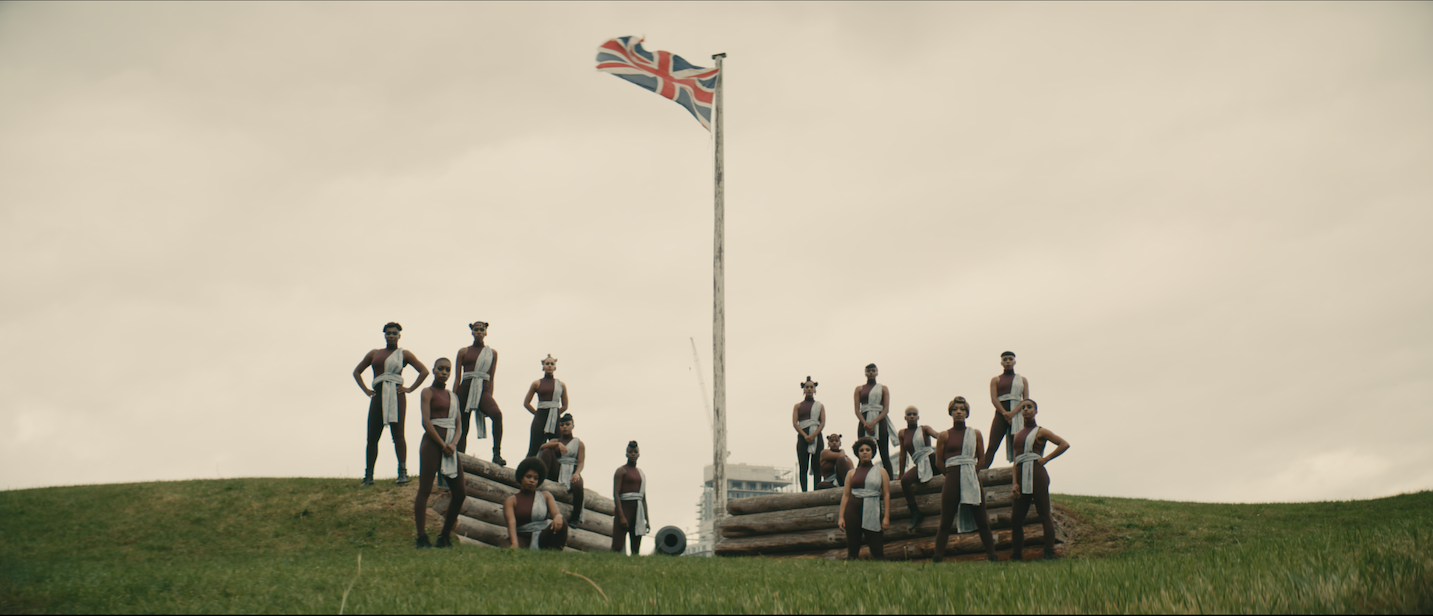
JH: In terms of influences for the piece, where did you draw? Whether it be cultural, justice movements, art, pop culture even.
EM: I was very curious about the ideas of a dancefilm — what is that? What does that mean? I’m not always the biggest fan of seeing dance on film, especially commercially, you know? You have Step Up 17 and you have your You Got Serves, and I often feel that the movement doesn’t serve the narrative, which is also an issue for me with musical theatre. Because you’re singing all of these beautiful songs, and then all of a sudden, you’re doing backflips. Like, how did that come up? [laughs]
Oftentimes I hear quite a few people say, ‘I don’t get dance.’ And I was like, ‘What do you mean by that? What do you mean, you don’t get dance?’ But then I was like, ‘Oh yeah, because dance doesn’t make it so that it’s accessible for people to understand it.’ When we do this thing and are like ‘You’re not supposed to understand it,’ I’m like, ‘Hmm. I think we need to do better at explaining it.’
So in the process of creating the film, I was looking up a lot of different dancefilm references and not really finding something that really spoke to me. And once we landed on the song, it was then going down a rabbit hole of understanding: who are these women and what are they saying? What is this? And then it was really beginning to look to the text as a way in. And it was interesting working with Weyni [Mengesha] especially because she’s a theatre director. She directs words; that’s what she’s absolutely phenomenal at. [laughs] So having to show her the beauty of how movement can help jump the story, you don’t need a lot of words when you have movement. So how do you create this hybrid?
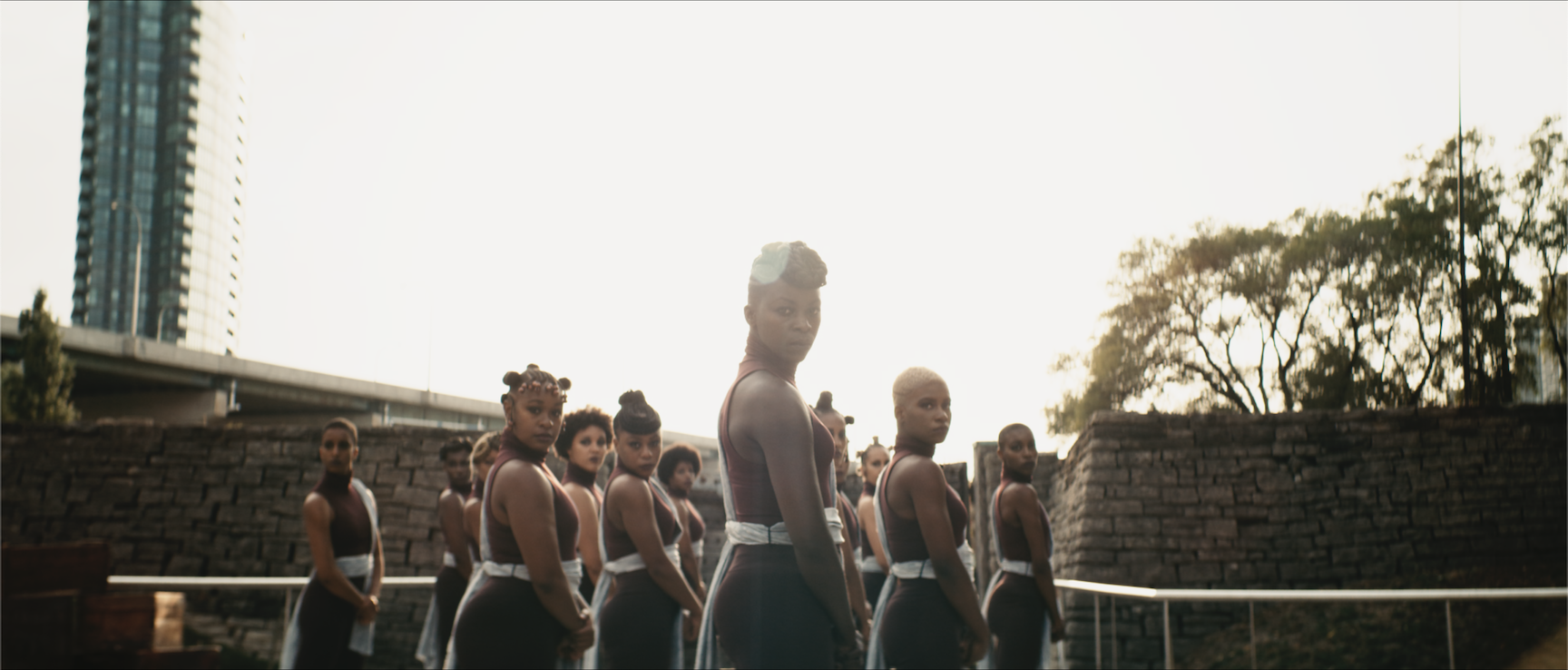
And it’s funny because only one little part of what I had initially choreographed for the intro was in it. That ended up transforming into us walking and the collective turn-and-look. Understanding what needs to be taken out in order to serve the story … Understanding that we’re following this journey of this woman as she’s coming to the Fort and it’s not going to serve the story if we just immediately jump into dance; therefore, we’re serving the choreography but not serving the story. I had to mourn the fact that many pieces of choreography had to get taken out of the piece in order to serve the actual narrative that we wanted to have.
I should also mention, because I don’t think I said it before, a lot of the story itself was really my life. [laughs] Because I had gone through everything that happened last year, with what has been happening for decades if not centuries. It’s nothing new for us as people of colour; it’s just new for everybody else that decided to see it for the first time. My energy had come to a head in May/June-ish of last year because I couldn’t mask the hurt. I was just so angry. I felt so heavy; I woke up every morning heavy. I wanted to go down the street and beat up some people. It was really a time.
JH: [laughing] Yep. Last year was a year!
EM: It really was. So coming into a full-circle moment — and I didn’t recognize it until we got closer into shooting, that I was like, ‘Oh, this was my life!’ [laughs] And my art sometimes does that. It’ll creep back in and say, like, ‘These are things that you’re already seeing that you didn’t quite pay enough attention to.’
And that idea of heaviness and the idea of, like, ‘What do we do? What is the solution? Where do we go?’ And I think that idea of finding the solution in the text and finding the solution in terms of how we set up the narrative, and allowing the words to take precedence but also be on a float with the movement, is really important because I’m just a person, and what’s the intention? How do we serve the intention? How do we really serve the work? How do we serve the art?
It’s interesting, choreographing from this place because it changes the way that you choreograph. Because if you’re trying to see in pictures and in moments, how do you create moments that have an effect on people through movement? And then thinking beyond those moments and thinking about the whole piece, how do you take a real-life situation and now manifest it into art? Which all was done subconsciously [laughs] and was definitely guided through that process. But it’s fairly interesting to see how the whole picture just comes into focus. Being patient enough to let that happen.
These are excerpts of a longer conversation and have been edited for clarity.
